A little history of studio glass......
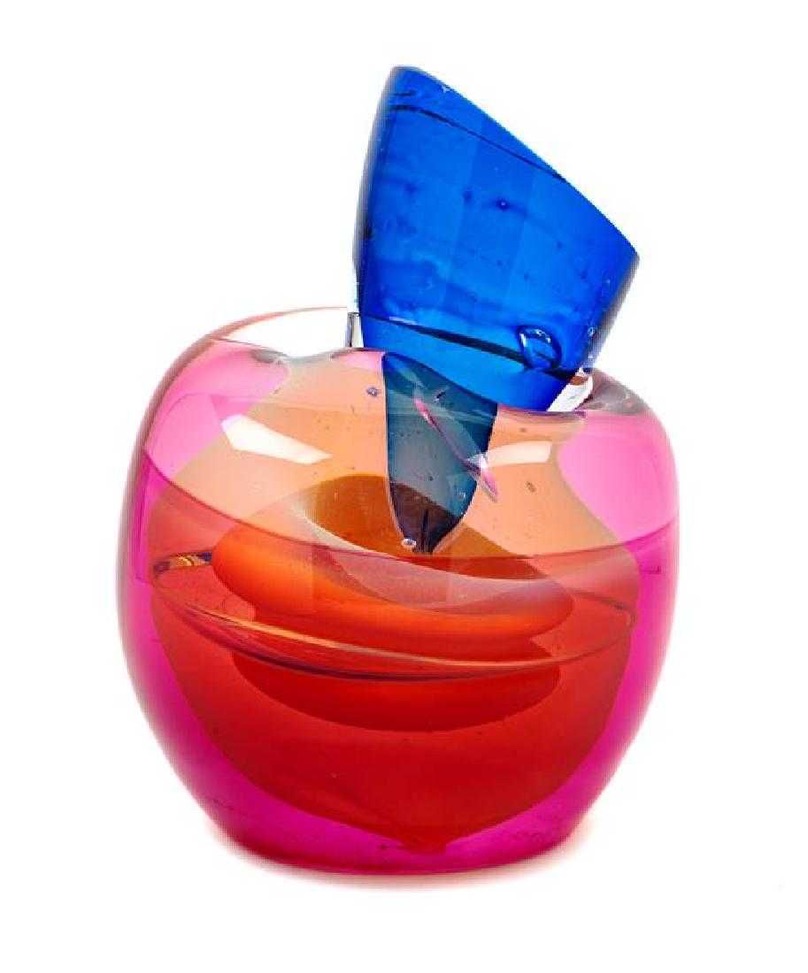
The international studio glass movement originated in America, spreading to Europe, the United Kingdom, Australia and Asia. The emphasis of this movement was on the artist as the designer and maker of one-of-a-kind objects, in a small studio environment. This movement enabled the sharing of technical knowledge and ideas among artists and designers that, in industry, would not be possible. [3]
[3]
With the dominance of  Modernism in the arts, there was a broadening of artistic media throughout the 20th century. Indeed, glass was part of the curriculum at art schools such as the
Modernism in the arts, there was a broadening of artistic media throughout the 20th century. Indeed, glass was part of the curriculum at art schools such as the  Bauhaus.
Bauhaus.  Frank Lloyd Wright's produced glass windows considered by some as masterpieces not only of design, but of painterly composition as well. During the 1950s, studio ceramics and other craft media in the U.S. began to gain in popularity and importance, and American artists interested in glass looked for new paths outside industry.
Frank Lloyd Wright's produced glass windows considered by some as masterpieces not only of design, but of painterly composition as well. During the 1950s, studio ceramics and other craft media in the U.S. began to gain in popularity and importance, and American artists interested in glass looked for new paths outside industry. [3]
[3]  Harvey Littleton, often referred to as the "Father of the Studio Glass Movement",
Harvey Littleton, often referred to as the "Father of the Studio Glass Movement", [4] was inspired to develop studio glassblowing in America by the great glass being designed and made in Italy, Sweden and many other places, and by the pioneering work in ceramics of the California potter
[4] was inspired to develop studio glassblowing in America by the great glass being designed and made in Italy, Sweden and many other places, and by the pioneering work in ceramics of the California potter  Peter Voulkos.
Peter Voulkos.  Harvey Littleton and
Harvey Littleton and  Dominick Labino held the now-famous glass workshop at the Toledo Museum of Art in 1962. The goal was to melt glass in a small furnace so individual artists could use glass as an art medium in a non-industrial setting. This was the workshop that would stimulate the studio glass movement that spread around the world. Instead of the large, industrial settings of the past, a glass artist could now work with a small glass furnace in an individual setting and produce art from glass.
Dominick Labino held the now-famous glass workshop at the Toledo Museum of Art in 1962. The goal was to melt glass in a small furnace so individual artists could use glass as an art medium in a non-industrial setting. This was the workshop that would stimulate the studio glass movement that spread around the world. Instead of the large, industrial settings of the past, a glass artist could now work with a small glass furnace in an individual setting and produce art from glass.
(wikipedia)
(GLASS LEFT: BY HARVEY LITTLETON, GLASS RIGHT: BY DOMINICK LABINO)
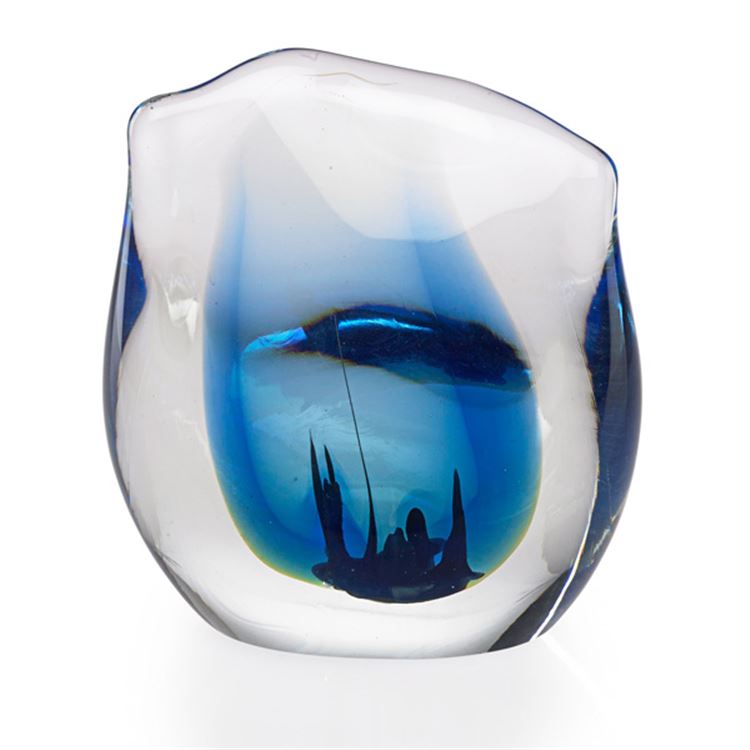
INGRID PEARS CONTEMPORARY STUDIO GLASS
History of Glass Making

FURNACE (LEFT) The transformation of raw materials into glass takes place around 1315°C; the glass emits enough heat to appear almost white hot. The glass is then left to "fine out" (allowing the  bubbles to rise out of the mass), and then the working temperature is reduced in the furnace to around 1100
bubbles to rise out of the mass), and then the working temperature is reduced in the furnace to around 1100 °C. At this stage, the glass appears to be a bright orange colour. Though most glassblowing is done between 870–1040°C, "Soda-lime" glass remains somewhat plastic and workable as low as 730°C. Annealing is usually done between 430–480°C. Ingrid Pears uses the finest crystal glass to produce her unique designs which remain maleable for some time.
°C. At this stage, the glass appears to be a bright orange colour. Though most glassblowing is done between 870–1040°C, "Soda-lime" glass remains somewhat plastic and workable as low as 730°C. Annealing is usually done between 430–480°C. Ingrid Pears uses the finest crystal glass to produce her unique designs which remain maleable for some time.
Glassblowing involves three furnaces. The first, which contains a  crucible of molten glass, is simply referred to as "the furnace." (LEFT)
crucible of molten glass, is simply referred to as "the furnace." (LEFT)
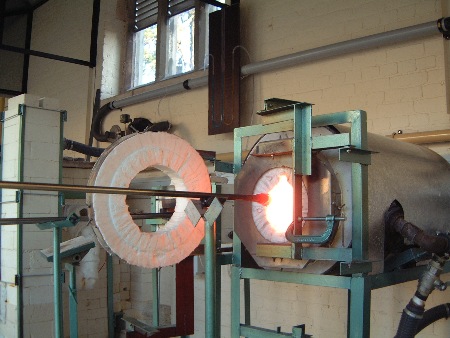
Glory hole (RIGHT) is used to reheat a piece in between steps of working with it. The final furnace is called the "lehr" or "annealer", and is used to slowly cool the glass, over a period of a few hours to a few days, depending on the size of the pieces. This keeps the glass from cracking due to  thermal stress. Historically, all three furnaces were contained in one, with a set of progressively cooler chambers for each of the three purposes. Many glassblowing studios in Mexico and South America still employ this method. Ingrid Pears uses three separate pieces of equipment.The major tools involved are the
thermal stress. Historically, all three furnaces were contained in one, with a set of progressively cooler chambers for each of the three purposes. Many glassblowing studios in Mexico and South America still employ this method. Ingrid Pears uses three separate pieces of equipment.The major tools involved are the  blowpipe (or blow tube), the
blowpipe (or blow tube), the  punty(pontil or punt), bench,
punty(pontil or punt), bench,  marver, seers, blocks, jacks,
marver, seers, blocks, jacks,  paddles,
paddles,  tweezers, and a variety of
tweezers, and a variety of  shears. The tip of the blowpipe is first preheated; then dipped in the molten glass in the furnace. The molten glass is 'gathered' on to the blowpipe in much the same way that
shears. The tip of the blowpipe is first preheated; then dipped in the molten glass in the furnace. The molten glass is 'gathered' on to the blowpipe in much the same way that  honey is picked up on a dipper.
honey is picked up on a dipper.
Then, this glass is rolled on the marver (Marvering) which was traditionally a flat slab of marble, but today is more commonly a fairly thick flat sheet of steel or graphite. This forms a cool skin on the exterior of the molten glass and shapes it. Then air is blown into the pipe, creating a bubble. Then, one can gather over that bubble to create a larger piece.
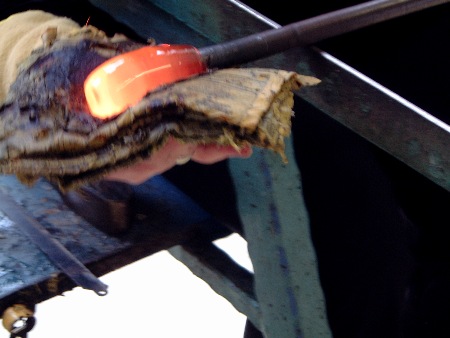
Blocks are ladle-like tools made from water-soaked fruit wood and are used similarly to the marver to shape and cool a piece in the early steps of creation. Newspaper (LEFT) can also be used to shape the glass. The glass floats on a bed of steam on the top surface of the newspaper and shapes the glass.
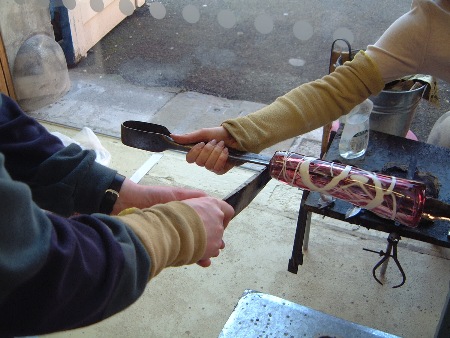
The bench is a glassblower's workstation, and has a place for the glassblower to sit, a place for the handheld tools, and two rails that the pipe or punty rides on while the blower works with the piece. Jacks are a tool shaped somewhat like large tweezers with two blades. Jacks are used for forming shape later in the creation of a piece. Paddles are flat pieces of wood or graphite used for creating flat spots like a bottom. Tweezers are used to pick out details or to pull on the glass. There are two important types of shears, straight shears and diamond shears. Straight shears are essentially bulky scissors, used for making linear cuts. Diamond shears have blades that form a diamond shape when partially open. These are used for cutting off masses of glass. Once a piece has been blown to its approximate final size, the bottom is finalized. Then, the piece is transferred to a punty, and the top is finalised.
There are many ways to apply patterns and colour to blown glass, including rolling molten glass in powdered colour or larger pieces of coloured glass called frit. Complex patterns with great detail can be created through the use of cane (rods of coloured glass) and murrine (rods cut in cross-sections to reveal patterns). These pieces of colour can be arranged in a pattern and 'picked up' by rolling a bubble of molten glass over them. One of the most exacting and complicated caneworking techniques is 'reticello', which involves creating two bubbles from cane, each twisted in a different direction and then combining them and blowing out the final form.

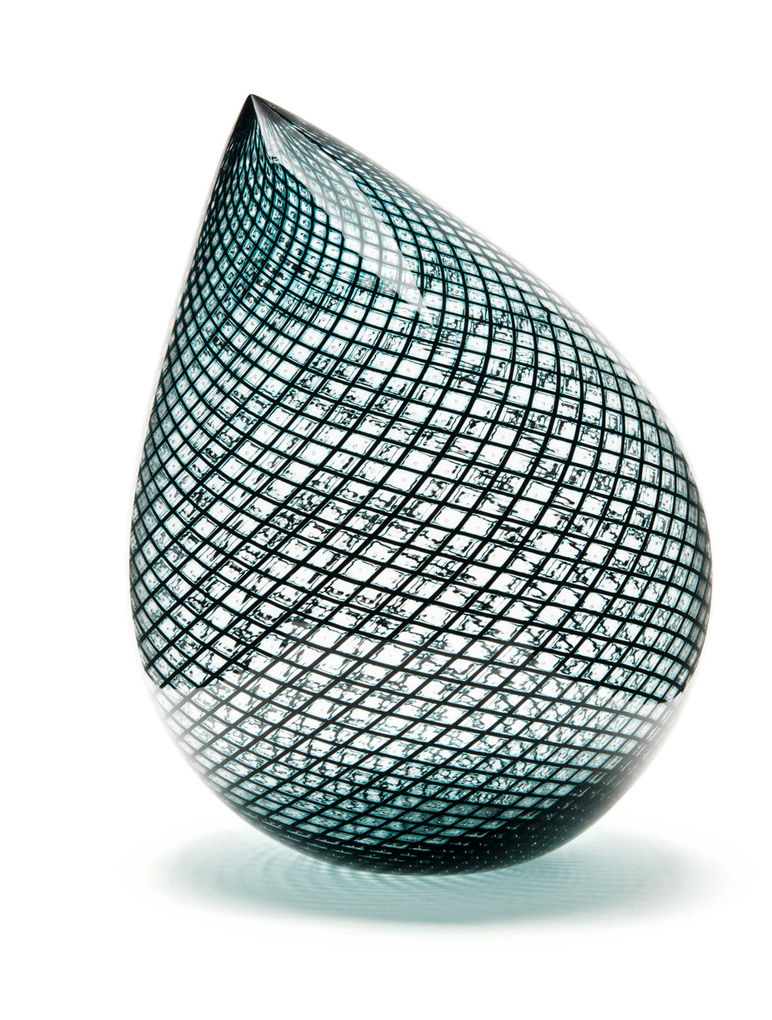
Reticello Raindrop by Mikey Cozza.